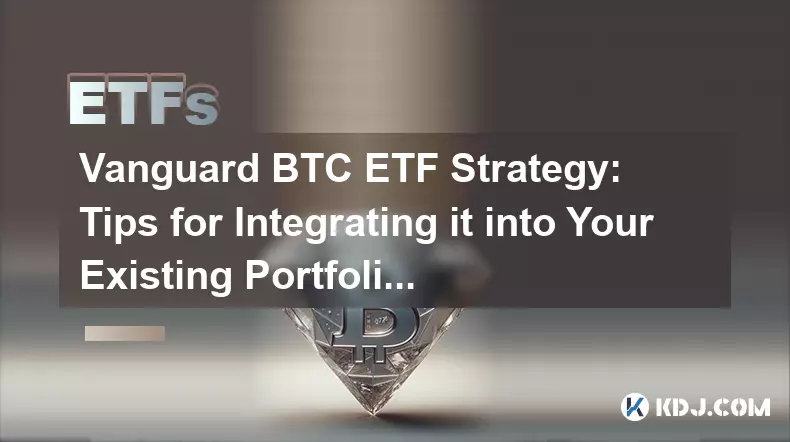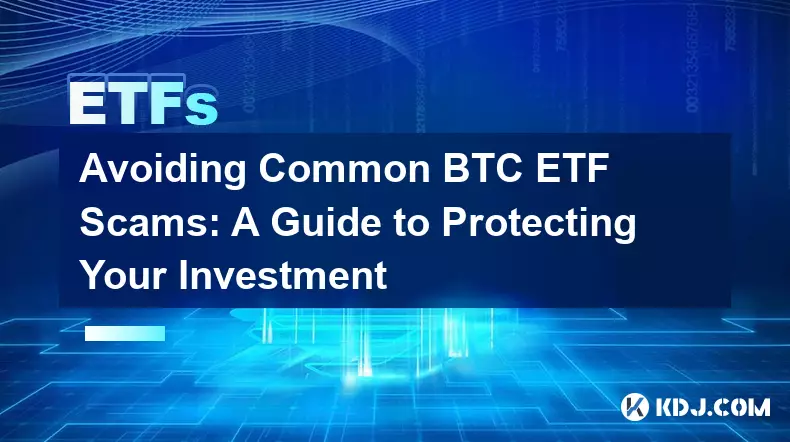-
 bitcoin
bitcoin $87959.907984 USD
1.34% -
 ethereum
ethereum $2920.497338 USD
3.04% -
 tether
tether $0.999775 USD
0.00% -
 xrp
xrp $2.237324 USD
8.12% -
 bnb
bnb $860.243768 USD
0.90% -
 solana
solana $138.089498 USD
5.43% -
 usd-coin
usd-coin $0.999807 USD
0.01% -
 tron
tron $0.272801 USD
-1.53% -
 dogecoin
dogecoin $0.150904 USD
2.96% -
 cardano
cardano $0.421635 USD
1.97% -
 hyperliquid
hyperliquid $32.152445 USD
2.23% -
 bitcoin-cash
bitcoin-cash $533.301069 USD
-1.94% -
 chainlink
chainlink $12.953417 USD
2.68% -
 unus-sed-leo
unus-sed-leo $9.535951 USD
0.73% -
 zcash
zcash $521.483386 USD
-2.87%
BTC ETF Risk Management: A Practical Guide to Protecting Your Capital
Effective risk management in BTC ETFs involves diversification, strict position sizing, and using tools like stop-loss orders and NAV tracking to protect against volatility and market shifts.
Nov 05, 2025 at 01:00 am

BTC ETF Risk Management: A Practical Guide to Protecting Your Capital
Investing in Bitcoin exchange-traded funds (ETFs) offers a regulated and accessible way to gain exposure to cryptocurrency markets. However, BTC ETFs are not immune to volatility, regulatory shifts, or market manipulation. Effective risk management is essential for preserving capital while navigating this evolving asset class.
Understanding BTC ETF-Specific Risks
1. BTC ETFs do not directly hold Bitcoin in the traditional sense; instead, they rely on custodial arrangements or futures contracts, introducing counterparty and custody risks.
- Regulatory uncertainty remains high, with potential changes in SEC guidelines or tax treatment affecting ETF valuation and investor sentiment.
- Premium/discount fluctuations between the ETF’s net asset value (NAV) and its market price can lead to mispricing, especially during periods of high volatility.
- Liquidity varies significantly across different BTC ETFs, with lower-volume products potentially exposing investors to wider bid-ask spreads and slippage.
- Market sentiment around macroeconomic indicators—such as interest rates or inflation—can disproportionately impact BTC ETF pricing due to their speculative nature.
Diversification and Position Sizing Strategies
1. Allocate only a defined percentage of your portfolio to BTC ETFs based on your risk tolerance, avoiding over-concentration in any single crypto-related product.
- Pair BTC ETF exposure with non-correlated assets such as bonds, commodities, or equities from defensive sectors to reduce overall portfolio volatility.
- Use dollar-cost averaging (DCA) when entering positions to mitigate the impact of short-term price swings and avoid timing the market.
- Consider geographic diversification by investing in BTC ETFs listed on multiple exchanges or jurisdictions to hedge against region-specific regulatory actions.
- Monitor sector weightings within broader portfolios to ensure that digital asset exposure does not unintentionally dominate risk profiles.
Monitoring Tools and Exit Mechanisms
1. Set predefined stop-loss orders based on technical support levels or volatility thresholds to automatically limit downside exposure.
- Utilize real-time NAV tracking tools provided by ETF issuers to identify significant deviations between market price and underlying asset value.
- Subscribe to regulatory news feeds and SEC filings to stay informed about policy developments that may affect BTC ETF operations.
- Track trading volume and open interest, particularly for futures-based BTC ETFs, as declining activity may signal weakening institutional interest.
- Establish profit-taking targets aligned with key resistance levels or macroeconomic events to lock in gains during bullish phases.
Frequently Asked Questions
What is the difference between a spot BTC ETF and a futures-based BTC ETF?A spot BTC ETF holds actual Bitcoin as its underlying asset, typically through secure custodians, and aims to track the current market price of Bitcoin directly. In contrast, a futures-based BTC ETF invests in Bitcoin futures contracts traded on regulated exchanges, which may result in pricing discrepancies due to contango or backwardation in the futures curve.
Can BTC ETFs be held in tax-advantaged accounts like IRAs?Yes, many BTC ETFs are eligible for inclusion in retirement accounts such as IRAs or 401(k)s, provided the custodian supports alternative asset classes. Investors should confirm eligibility with their financial institution before purchasing.
How do expense ratios impact long-term returns on BTC ETFs?Expense ratios represent annual fees charged by the ETF provider and are deducted from fund assets. Even small differences in fees—such as 0.75% versus 0.95%—can erode returns over time, especially in a volatile or sideways market where capital appreciation is limited.
Are BTC ETFs susceptible to insider trading or market manipulation?While regulated exchanges and oversight reduce the likelihood of manipulation compared to direct crypto exchanges, large institutional trades or coordinated positioning in futures markets can still influence ETF prices. Transparency in holdings and audit trails help mitigate these risks but do not eliminate them entirely.
Disclaimer:info@kdj.com
The information provided is not trading advice. kdj.com does not assume any responsibility for any investments made based on the information provided in this article. Cryptocurrencies are highly volatile and it is highly recommended that you invest with caution after thorough research!
If you believe that the content used on this website infringes your copyright, please contact us immediately (info@kdj.com) and we will delete it promptly.
- Ethereum's Gas Limit Jumps: A Scaling Upgrade for the Ages
- 2025-11-28 15:15:02
- Altcoin Price Prediction: Navigating Market Signals for Profit
- 2025-11-28 15:20:02
- Gold Shines as AI Bubble Fears Inflate: A Hedge Against Uncertainty
- 2025-11-28 15:15:02
- Ripple's RLUSD Gains Momentum in Abu Dhabi and Beyond
- 2025-11-28 15:10:01
- Coinbase Stock: Navigating Subscription Growth and Trading Volatility in the Crypto Age
- 2025-11-28 15:10:01
- Bitcoin Price Stability and Future Rise: What's Next?
- 2025-11-28 15:05:01
Related knowledge

The Psychology of BTC ETF Investing: A Guide to Managing Fear and Greed
Nov 05,2025 at 03:44am
The Emotional Triggers Behind Bitcoin ETF Investment Decisions1. Investors often react impulsively when they see sudden spikes in Bitcoin ETF inflows,...

Is Your BTC ETF Insured?: A Guide to SIPC and Custodian Protections
Nov 05,2025 at 01:20pm
Understanding BTC ETFs and Investor Protection1. Bitcoin exchange-traded funds (ETFs) have introduced a new layer of accessibility for traditional inv...

BTC ETF Performance Tracking: Tools and Tips for Monitoring Your Investment
Nov 01,2025 at 07:19am
BTC ETF Performance Tracking: Essential Tools1. Utilizing financial data platforms like Bloomberg, Yahoo Finance, and CoinDesk provides real-time upda...

Vanguard BTC ETF Strategy: Tips for Integrating it into Your Existing Portfolio
Nov 03,2025 at 02:00pm
Vanguard BTC ETF Strategy: Key Considerations for Portfolio Integration1. The introduction of a Vanguard Bitcoin ETF strategy marks a pivotal shift in...

The 2024 BTC ETF Investor's Guide: Strategies for the Current Market
Nov 04,2025 at 08:39pm
The 2024 BTC ETF Investor's Guide: Strategies for the Current Market 1. The introduction of Bitcoin exchange-traded funds (ETFs) in 2024 has fundament...

Avoiding Common BTC ETF Scams: A Guide to Protecting Your Investment
Nov 05,2025 at 10:45am
Emerging Trends in the Cryptocurrency Market1. Decentralized finance (DeFi) platforms continue to reshape how users interact with digital assets, offe...

The Psychology of BTC ETF Investing: A Guide to Managing Fear and Greed
Nov 05,2025 at 03:44am
The Emotional Triggers Behind Bitcoin ETF Investment Decisions1. Investors often react impulsively when they see sudden spikes in Bitcoin ETF inflows,...

Is Your BTC ETF Insured?: A Guide to SIPC and Custodian Protections
Nov 05,2025 at 01:20pm
Understanding BTC ETFs and Investor Protection1. Bitcoin exchange-traded funds (ETFs) have introduced a new layer of accessibility for traditional inv...

BTC ETF Performance Tracking: Tools and Tips for Monitoring Your Investment
Nov 01,2025 at 07:19am
BTC ETF Performance Tracking: Essential Tools1. Utilizing financial data platforms like Bloomberg, Yahoo Finance, and CoinDesk provides real-time upda...

Vanguard BTC ETF Strategy: Tips for Integrating it into Your Existing Portfolio
Nov 03,2025 at 02:00pm
Vanguard BTC ETF Strategy: Key Considerations for Portfolio Integration1. The introduction of a Vanguard Bitcoin ETF strategy marks a pivotal shift in...

The 2024 BTC ETF Investor's Guide: Strategies for the Current Market
Nov 04,2025 at 08:39pm
The 2024 BTC ETF Investor's Guide: Strategies for the Current Market 1. The introduction of Bitcoin exchange-traded funds (ETFs) in 2024 has fundament...

Avoiding Common BTC ETF Scams: A Guide to Protecting Your Investment
Nov 05,2025 at 10:45am
Emerging Trends in the Cryptocurrency Market1. Decentralized finance (DeFi) platforms continue to reshape how users interact with digital assets, offe...
See all articles





















![[4K 60fps] Beach Blast by AllieKat (1 Coin) [4K 60fps] Beach Blast by AllieKat (1 Coin)](/uploads/2025/11/28/cryptocurrencies-news/videos/origin_6928f48c22082_image_500_375.webp)



![(Daily Level) 'DASH TOWER' BY Dymond16 [2/3 COINS] (Daily Level) 'DASH TOWER' BY Dymond16 [2/3 COINS]](/uploads/2025/11/28/cryptocurrencies-news/videos/origin_6928f9299cc8a_image_500_375.webp)
















































